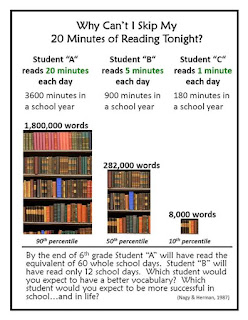If you follow this blog, you've already shown that you believe books matter. Here's why.
- Improve a child’s reading performance.
- Cause children to read more and for longer lengths of time, critical for success in school
- Produce improved attitudes toward reading and learning among children. (1)
- Children who live in print-rich environments and who are read to during the first years of life are much more likely to learn to read on schedule. (2)
Even a child who hails from a home with 25 books will, on average, complete two more years of school than would a child from a home without any books at all. Evans, Kelley, Sikorac, and Treimand (2010)
“A home with books as an integral part of the way of life encourages children to read for pleasure and encourages discussion among family members about what they have read," Evans and her colleagues write, "thereby providing children with information, vocabulary, imaginative richness, wide horizons, and skills for discovery and play.”
In an unprecedented search uncovering 11,000 reports and analyzing 108 of the most relevant studies, children’s book distribution and ownership programs were shown to have positive behavioral, educational, and psychological outcomes. The researchers also suggest that a reciprocal relationship may exist between access and outcomes; in other words, providing interesting written materials to children increases their reading behavior and achievement, which then, in turn, further increases their desire to read and acquire more books. McGill-Franzen, et al., 1999
How do you build home libraries?
- Buy books. They don't have to be new. Look for books at yard/garage sales, public library sales. Make sure the books are in good condition, and are current titles. Books that are shopworn, moldy damaged do not send a positive message about the value of books and reading.
- Accept the fact that your child may or may not like the same books you liked when you were a kid. However, movies (Jumanji, again!) and re-boots as graphic novels (Babysitters Club, Hardy Boys, etc.) are reaching a new generation. Let them choose. Research shows that kids will read if you connect them with an author, genre or series.
- Ask your school librarian what they do with weeded books.
- Swap with neighbors.
- Look for, or build, a "little free library" in your neighborhood; it's a great youth group/Eagle Scout project! It doesn't have to be outside. Consider placing one in your place of worship, daycare/preschool.
- Advocate. Ask your pediatrician if they know about "Reach Out and Read", a program where books and reading are "prescribed" as part of the child's neurological and linguistic development.

